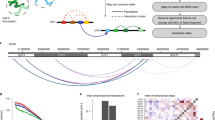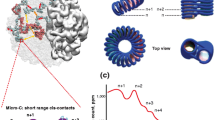Abstract
During the early phase of the cell cycle the eukaryotic genome is organized into chromosome territories. The geometry of the interface between any two chromosomes remains a matter of debate and may have important functional consequences. The Interchromosomal Network model (introduced by Branco and Pombo) proposes that territories intermingle along their periphery. In order to partially quantify this concept we here investigate the probability that two chromosomes form an unsplittable link. We use the uniform random polygon as a crude model for chromosome territories and we model the interchromosomal network as the common spatial region of two overlapping uniform random polygons. This simple model allows us to derive some rigorous mathematical results as well as to perform computer simulations easily. We find that the probability that one uniform random polygon of length n that partially overlaps a fixed polygon is bounded below by \({1-O(\frac{1}{\sqrt n})}\). We use numerical simulations to estimate the dependence of the linking probability of two uniform random polygons (of lengths n and m, respectively) on the amount of overlapping. The degree of overlapping is parametrized by a parameter \({\epsilon\in [0,1]}\) such that \({\epsilon=0}\) indicates no overlapping and \({\epsilon=1}\) indicates total overlapping. We propose that this dependence relation may be modeled as \({f(\varepsilon, m, n) =1-{\frac{a(\epsilon)}{b(\epsilon)\sqrt{mn}+c(\epsilon)}}}\). Numerical evidence shows that this model works well when \({\epsilon}\) is relatively large \({(\varepsilon \ge 0.5)}\). We then use these results to model the data published by Branco and Pombo and observe that for the amount of overlapping observed experimentally the URPs have a non-zero probability of forming an unsplittable link.
Similar content being viewed by others
References
Albiez H et al (2006) Chromatin domains and the interchromatin compartment form structurally defined and functionally interacting nuclear networks. Chromosome Res 14(7): 707–733
Arsuaga J et al (2004) Chromosome positioning through radiogenic aberrations. Int J Radiat Biol 80: 507–516
Arsuaga J et al (2005) DNA knots reveal a chiral organization of DNA in phage capsids. Proc Natl Acad Sci USA 102(26): 9165–9169
Arsuaga J et al (2007a) Linking of uniform Random Polygons in Confined Spaces. J Phys A 40: 1925–1936
Arsuaga J et al (2007b) Sampling large random knots in a confined space. J Phys A 40: 11697–11711
Boutz DR et al (2007) Discovery of a thermophilic protein complex stabilized by topologically interlinked chains. J Mol Biol 368: 1332–1344
Branco M, Pombo A (2006) Intermingling of chromosome territories in interphase suggests role in translocations and transcription-dependent associations. PLoS Biol 4: 780–788
Branco M, Pombo A (2007) Chromosome organization: new facts, new models. Trends Cell Biol 17(3): 127–134
Connolly ML, Kuntz ID, Crippen GM (1980) Linked and threaded loops in proteins. Biopolymers 19: 1167–1182
Conrforth M et al (2002) Chromosomes are predominantly located randomly with respect to each other in interphase human cells. J Cell Biol 78: 1103–1115
Cook PR, Marenduzzo D (2009) Entropic organization of interphase chromosomes. J Cell Biol 186: 825–834
Cremer T, Küpper K, Dietzel S, Fakan S (2004) Higher order chromatin architecture in the cell nucleus: on the way from structure to function. Biol Cell 96: 555–567
Deguchi T, Tsurusaki K (1997) Random knots and links and applications to polymer physics. Lectures at Knots 96. In: Suzuki S (ed) World Scientific Publishing Co., pp 95–122
Dorier J, Stasiak A (2009) Topological origins of chromosomal territories. Nucleic Acids Res 37(19): 6316–6322
Duan ZH, Howard LN (1998) Loop entanglement of semicrystalline polyethylene in amorphous region: Diamond lattice approach. J Comput Chem 20(3): 348–353
Duda RL (1998) Protein chainmail: catenated protein in viral capsids. Cell 94: 55–60
Fraser P, Bickmore W (2007) Nuclear organization of the genome and the potential for gene regulation. Nature 447(7143): 413–417
Grainge I et al (2007) Unlinking chromosome catenanes in vivo by site-specific recombination. EMBO J 26: 4228–4238
Grosberg AY, Nechaev SK, Nechaev SK (1988) Role of topological limitations in the kinetics of homopolymer collapse and in selforganization of bio-polymers. Biofizika 33: 247–253
Hirayama N, Tsurusaki K, Deguchi T (2009) Linking probabilities of off-lattice self-avoiding polygons and the effects of excluded volume. J Phys A 42(10): 105001
Klenin K, Langowski J (2000) Computation of writhe in modeling of supercoiled DNA. Biopolymers 54(5): 307–317
Klenin KV et al (1989) Variance of writhe for wormlike DNA rings with excluded volume. J Biomol Struct Dyn 6(4): 707–714
Lacher RC, Bryant JL, Howard LN, Sumners DW (1986) Loop entanglement in a constrained liquid region: simulation data, simplified models, and general measurement heuristics. Macromolecules 19(10): 2639–2643
Lieberman-Aiden E et al (2009) Comprehensive mapping of long-range interactions reveals folding principles of the human genome. Science 326(5950): 289–293
Liu B et al (2005) Fellowship of the rings: the replication of kinetoplast DNA. Trends Parasitol 21: 363–369
Maniotis AJ, Bojanowski K, Ingber DE (1997) Mechanical continuity and reversible chromosome disassembly within intact genomes removed from living cells. J Cell Biochem 65(1): 114–130
Mansfield ML (1994) Knots in Hamilton cycles. Macromolecules 27: 5924–5926
Mateos-Langerak J et al (2009) Spatially confined folding of chromatin in the interphase nucleus. Proc Natl Acad Sci USA 106(10): 3812–3817
Meaburn KJ, Misteli T, Soutoglu E (2007) Spatial genome organization in the formation of chromosomal translocations. Semin Cancer Biol 17(1): 80–90
Millett K (2000) Monte Carlo explorations of polygonal knot spaces. Knots in Hellas’98 (Delphi), Series on Knots and Everything 24, World Scientific, Singapore, pp 306–334
Munkel C et al (1999) Compartmentalization of interphase chromosomes observed in simulation and experiment. J Mol Biol 285(3): 1053–1065
Noordermeer D et al (2008) Transcription and chromatin organization of a housekeeping gene cluster containing an integrated beta-globin locus control region. PLoS Genet 4(3): e1000016
Orlandini E, Janse van Rensburg EJ, Tesi MC, Whittington SG (1994) Random Linking of Lattice Polygons. J Phys A 27(2): 335–345
Orlandini E, Whittington SG (2004) Entangled polymers in condensed phases. J Chem Phys 121: 12094–12099
Orlandini E, Tesi MC, Whittington SG (2000) Polymer Entanglement in Melts. J Phys A 33: 181–186
Rosa A, Everaers R (2008) Structure and dynamics of interphase chromosomes. PLoS Comput Biol 4: e1000153
Sachs RK et al (1995) A random-walk/giant-loop model for interphase chromosomes. Proc Natl Acad Sci USA 92(7): 2710–2714
Sikorav JL, Jannink G (1994) Kinetics of chromosome condensation in the presence of topoisomerases: a phantom chain model. J Biophys 66: 827–837
Soteros CE, Sumners DW, Whittington SG (1999) Randomly linked p-spheres in Zd. J Knot Theory Ramif 8: 49–70
Sumners DW, Ernst C, Spengler SJ, Cozzarelli NR (1995) Analysis of the mechanism of DNA recombination using tangles. Q Rev Biophys 28(3): 253–313
Vettorel T et al (2009) Statistics of polymer rings in the melt: a numerical simulation study. Phys Biol 6: 025013
Wikoff WR et al (2000) Topologically linked protein rings in the bacteriophage HK97 capsid. Science 289: 2129–2133
Yokota H et al (1995) Evidence for the organization of chromatin in megabase pair-sized loops arranged along a random walk path in the human G0/G1 interphase nucleus. J Cell Biol 130(60): 1239–1249
Zechiedrich EL, Khodursky AB, Cozzarelli NR (1997) Topoisomerase IV, not gyrase, decatenates products of site-specific recombination in Escherichia coli. Genes Dev 11(19): 2580–2592
Author information
Authors and Affiliations
Corresponding author
Rights and permissions
About this article
Cite this article
Blackstone, T., Scharein, R., Borgo, B. et al. Modeling of chromosome intermingling by partially overlapping uniform random polygons. J. Math. Biol. 62, 371–389 (2011). https://doi.org/10.1007/s00285-010-0338-8
Received:
Revised:
Published:
Issue Date:
DOI: https://doi.org/10.1007/s00285-010-0338-8




